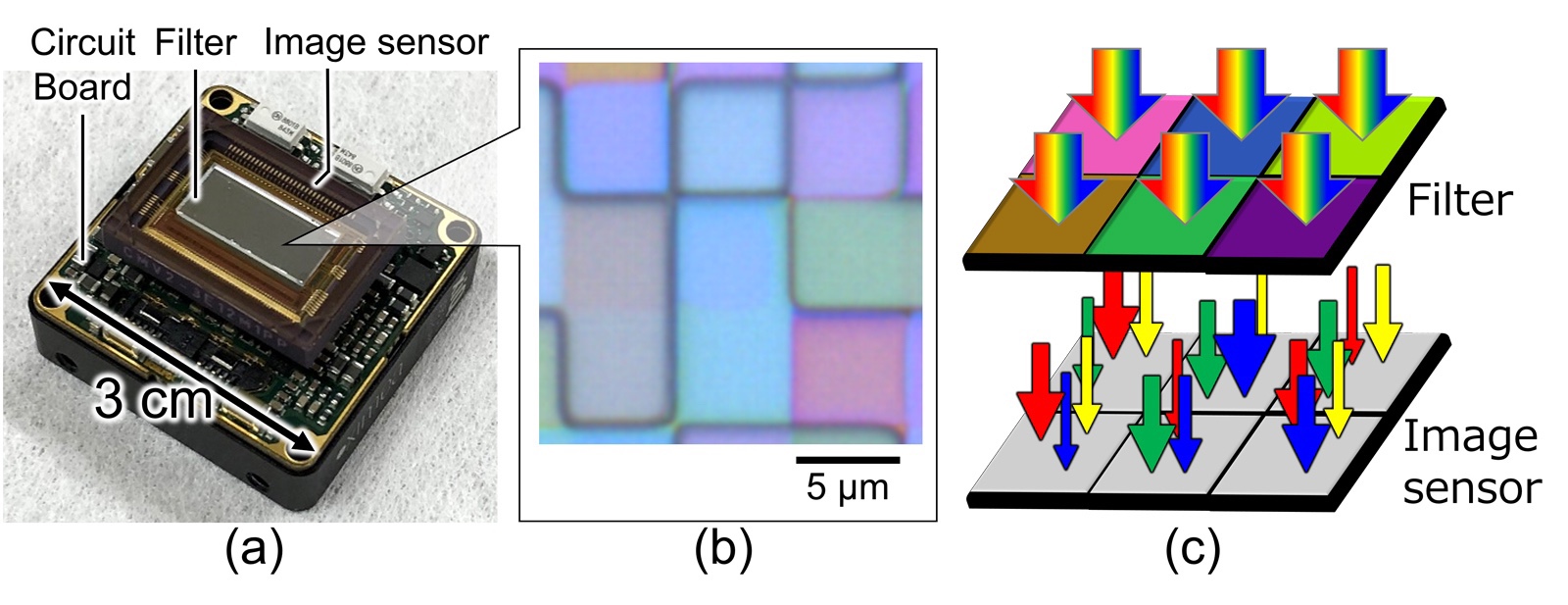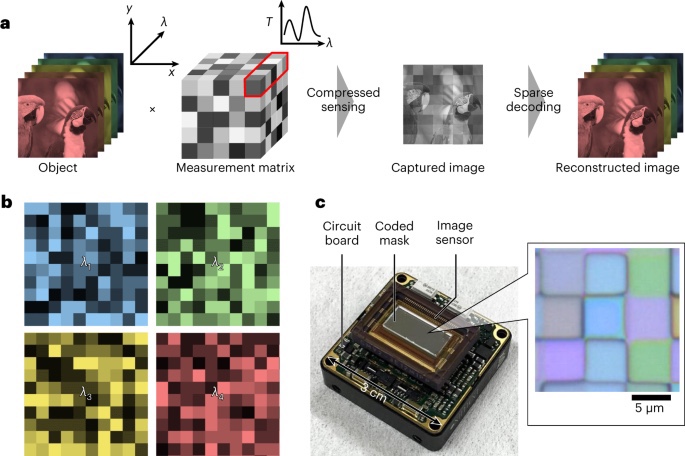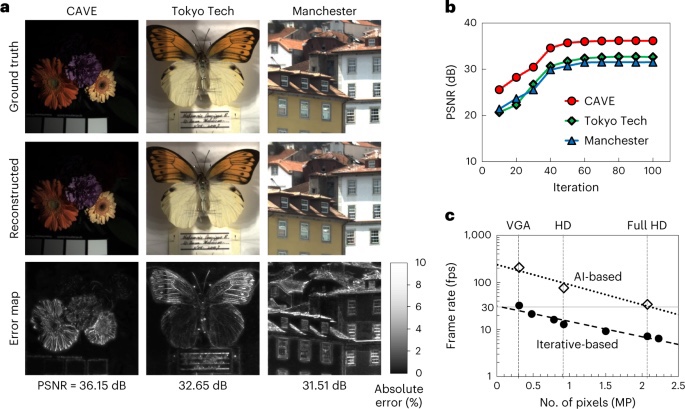


World’s Highest Sensitivity: Hyperspectral Imaging!
-Jointly developed by Panasonic and imec of Belgium-
Panasonic:
Panasonic has developed hyperspectral imaging technology with the world’s highest sensitivity.
It was developed using “compressed sensing technology, which is being used in the medical and space exploration fields.”
High sensitivity hyperspectral
imaging technology
ーIntroduced for appearance inspections at factoriesー
Consider co-creation with partners to expand machine vision applications.
Introduction of new technology:
Slight color differences that cannot be discerned with the naked eye can be discerned with the same operability as a conventional color camera.
It is possible to improve the accuracy of image analysis and recognition.
Belgium
research institute imec
As the world’s first research result, jointly with the Belgian research institute imec,
It was published in the online version of “Nature Photonics” in the field of optics on the 24th (Japan time).
Developed special filters:
For hyperspectral imaging technology, we developed a special filter that allows light of multiple wavelengths to pass through.
It can be mounted on a commercially available image sensor.
The data of the light (wavelength) that has passed through is restored using a “unique digital image processing algorithm”.
Role of special filters:
The special filter filters the light emitted from the target,
By randomly changing the intensity of each pixel and each wavelength,
designed to pass through.
To efficiently thin out and detect color information.
Since light of multiple wavelengths passes through, more light can be detected by the image sensor, improving its sensitivity.
Special filter sensitivity:
The developed special filter passes 45% of incident light.
It is 10 times higher than the “light utilization efficiency of conventional technology (5% or less)” and the world’s highest sensitivity.
You can shoot clearly even with “brightness of general office lighting (550 lux)”.
Improved image analysis accuracy:
It can detect 20 wavelengths and a great amount of color information.
Image recognition accuracy is improved compared to “naked eyes and color cameras that can distinguish only three colors, red, green, and blue.”
Applications of special filters:
High sensitivity allows shooting with a short shutter time.
Color separation on the software is speeded up with a unique algorithm.
We succeeded in “acquisition of high-speed hyperspectral images with a frame rate exceeding 30 fps”.
Easy operations such as focusing and positioning
Inspection of freshness of perishables and pharmaceuticals,
Detection of coating irregularities that cannot be discerned by the human eye,
A wide range of applications can be expected.
(Denpa Shimbun Digital)-Yahoo! News
https://news.yahoo.co.jp/articles/fdb142109ad6d68831ea0a29dcceac8f00a534a9
Video-rate hyperspectral camera based on a CMOS-compatible random array of Fabry–Pérot filters | Nature Photonics
https://www.nature.com/articles/s41566-022-01141-5
La sensibilité la plus élevée au monde : l’imagerie hyperspectrale !
-Développé conjointement par Panasonic et imec de Belgique-
Panasonic :
Panasonic a développé une technologie d’imagerie hyperspectrale avec la sensibilité la plus élevée au monde.
Il a été développé en utilisant “la technologie de détection compressée, qui est utilisée dans les domaines médical et de l’exploration spatiale”.
Hyperspectral haute sensibilité
technologie d’imagerie
ー Introduit pour les inspections d’apparence dans les usines ー
Envisagez la co-création avec des partenaires pour étendre les applications de vision industrielle.
Introduction de nouvelles technologies :
De légères différences de couleur qui ne peuvent pas être discernées à l’œil nu peuvent être discernées avec la même opérabilité qu’une caméra couleur conventionnelle.
Il est possible d’améliorer la précision de l’analyse et de la reconnaissance des images.
Belgique
institut de recherche imec
En tant que premier résultat de recherche au monde, en collaboration avec l’institut de recherche belge imec,
Il a été publié dans la version en ligne de “Nature Photonics” dans le domaine de l’optique le 24 (heure du Japon).
Filtres spéciaux développés :
Pour la technologie d’imagerie hyperspectrale, nous avons développé un filtre spécial qui laisse passer la lumière de plusieurs longueurs d’onde.
Il peut être monté sur un capteur d’image disponible dans le commerce.
Les données de la lumière (longueur d’onde) qui a traversé sont restaurées à l’aide d’un “algorithme unique de traitement d’image numérique”.
Rôle des filtres spéciaux :
Le filtre spécial filtre la lumière émise par la cible,
En changeant aléatoirement l’intensité de chaque pixel et de chaque longueur d’onde,
conçu pour traverser.
Pour éclaircir et détecter efficacement les informations de couleur.
Étant donné que la lumière de plusieurs longueurs d’onde passe à travers, plus de lumière peut être détectée par le capteur d’image, améliorant sa sensibilité.
Sensibilité spéciale du filtre :
Le filtre spécial développé laisse passer 45 % de la lumière incidente.
Il est 10 fois plus élevé que “l’efficacité d’utilisation de la lumière de la technologie conventionnelle (5% ou moins)” et la sensibilité la plus élevée au monde.
Vous pouvez filmer clairement même avec “la luminosité de l’éclairage général du bureau (550 lux)”.
Amélioration de la précision de l’analyse des images :
Il peut détecter 20 longueurs d’onde et une grande quantité d’informations de couleur.
La précision de la reconnaissance d’image est améliorée par rapport aux “yeux nus et aux caméras couleur qui ne peuvent distinguer que trois couleurs, le rouge, le vert et le bleu”.
Applications des filtres spéciaux :
La sensibilité élevée permet de prendre des photos avec un temps d’obturation court.
La séparation des couleurs sur le logiciel est accélérée grâce à un algorithme unique.
Nous avons réussi “l’acquisition d’images hyperspectrales à haute vitesse avec une fréquence d’images supérieure à 30 fps”.
Opérations simples telles que la mise au point et le positionnement
Contrôle de fraîcheur des denrées périssables et pharmaceutiques,
Détection d’irrégularités de revêtement non discernables par l’œil humain,
Une large gamme d’applications peut être attendue.
(Denpa Shimbun Digital) – Yahoo Actualités
Weltweit höchste Empfindlichkeit: Hyperspektrale Bildgebung!
-Gemeinsam entwickelt von Panasonic und imec aus Belgien-
Panasonic:
Panasonic hat eine hyperspektrale Bildgebungstechnologie mit der weltweit höchsten Empfindlichkeit entwickelt.
Es wurde unter Verwendung von “komprimierter Sensortechnologie entwickelt, die in den Bereichen Medizin und Weltraumforschung eingesetzt wird”.
Hyperspektral mit hoher Empfindlichkeit
bildgebende Technologie
ーEingeführt für Erscheinungsinspektionen in Fabrikenー
Erwägen Sie die gemeinsame Entwicklung mit Partnern, um Anwendungen für maschinelles Sehen zu erweitern.
Einführung neuer Technologien:
Leichte Farbunterschiede, die mit bloßem Auge nicht erkennbar sind, können mit der gleichen Bedienbarkeit wie bei einer herkömmlichen Farbkamera erkannt werden.
Es ist möglich, die Genauigkeit der Bildanalyse und -erkennung zu verbessern.
Belgien
Forschungsinstitut imec
Als weltweit erstes Forschungsergebnis, gemeinsam mit dem belgischen Forschungsinstitut imec,
Es wurde in der Online-Version von „Nature Photonics“ im Bereich Optik am 24. (japanische Zeit) veröffentlicht.
Entwickelte Spezialfilter:
Für die hyperspektrale Bildgebungstechnologie haben wir einen speziellen Filter entwickelt, der Licht mehrerer Wellenlängen durchlässt.
Es kann auf einem handelsüblichen Bildsensor montiert werden.
Die Daten des durchgegangenen Lichts (Wellenlänge) werden mit einem „einzigartigen digitalen Bildverarbeitungsalgorithmus“ wiederhergestellt.
Rolle von Spezialfiltern:
Der Spezialfilter filtert das vom Ziel emittierte Licht,
Durch zufälliges Ändern der Intensität jedes Pixels und jeder Wellenlänge,
zum Durchfahren ausgelegt.
Zum effizienten Ausdünnen und Erkennen von Farbinformationen.
Da Licht mit mehreren Wellenlängen hindurchgeht, kann mehr Licht vom Bildsensor erfasst werden, wodurch seine Empfindlichkeit verbessert wird.
Spezielle Filterempfindlichkeit:
Der entwickelte Spezialfilter lässt 45 % des einfallenden Lichts durch.
Sie ist zehnmal höher als die „Lichtnutzungseffizienz herkömmlicher Technologie (5 % oder weniger)“ und die weltweit höchste Empfindlichkeit.
Sie können auch mit “Helligkeit der allgemeinen Bürobeleuchtung (550 Lux)” scharfe Aufnahmen machen.
Verbesserte Genauigkeit der Bildanalyse:
Es kann 20 Wellenlängen und eine große Menge an Farbinformationen erkennen.
Die Bilderkennungsgenauigkeit wird im Vergleich zu „mit bloßem Auge und Farbkameras, die nur drei Farben, Rot, Grün und Blau, unterscheiden können“, verbessert.
Anwendungen von Spezialfiltern:
Die hohe Empfindlichkeit ermöglicht Aufnahmen mit kurzer Verschlusszeit.
Die Farbtrennung in der Software wird durch einen einzigartigen Algorithmus beschleunigt.
Uns gelang die „Erfassung von Hochgeschwindigkeits-Hyperspektralbildern mit einer Bildrate von mehr als 30 fps“.
Einfache Operationen wie Fokussieren und Positionieren
Frischekontrolle von verderblichen Waren und Arzneimitteln,
Erkennung von Beschichtungsunregelmäßigkeiten, die für das menschliche Auge nicht erkennbar sind,
Ein breites Anwendungsspektrum ist zu erwarten.
(Denpa Shimbun Digital) – Yahoo!-Nachrichten
Panasonic Develops Hyperspectral Imaging Technology with the World’s Highest Sensitivity
Panasonic Newsroom Global
The newly developed hyperspectral imaging technology employs compressed sensing,
which efficiently acquires observation data by “thinning out” and reconstructing data to restore data to what it was before thinning out through image post-processing.
The compressed sensing technology
is also used in MRI examinations in the medical field as well as black hole observations.
A special filter
that transmits multiple wavelengths of light to appropriately thin out data is implemented on an image sensor (Fig. 1),
and the image reconstruction is carried out by a uniquely optimized algorithm for digital image processing.
By leaving a part of the color-separating functions to the software,
Panasonic Holdings have overcome the trade-off between the number of wavelengths and sensitivity, the fundamental issue of conventional technology.
This approach has made it possible
to capture hyperspectral images with the world’s highest sensitivity (Fig. 2) and video (Fig. 3) under indoor illumination (550 lux).
Utilizing the developed technology, Panasonic Holdings will collaborate with our partners to provide new spectral sensing solutions,
including highly accurate image analysis and recognition, and to expand machine vision applications with highly sensitive hyperspectral imaging technology.
Main features
1. Improve sensitivity beyond physical restrictions through data acquisition with thinning out using a special filter randomly transmitting multiple wavelengths of light.
2. Achieves clear images even in indoor illumination (550 lux) through hyperspectral imaging with the world’s highest sensitivity (about 10 times higher than conventional ones).
3. Achieves hyperspectral imaging with color camera-comparable usability by improving frame rates*5 to levels as high as video-rates (over 30 fps) via a uniquely developed algorithm.